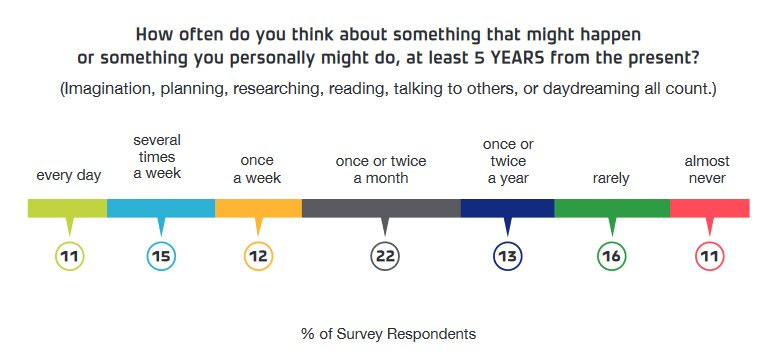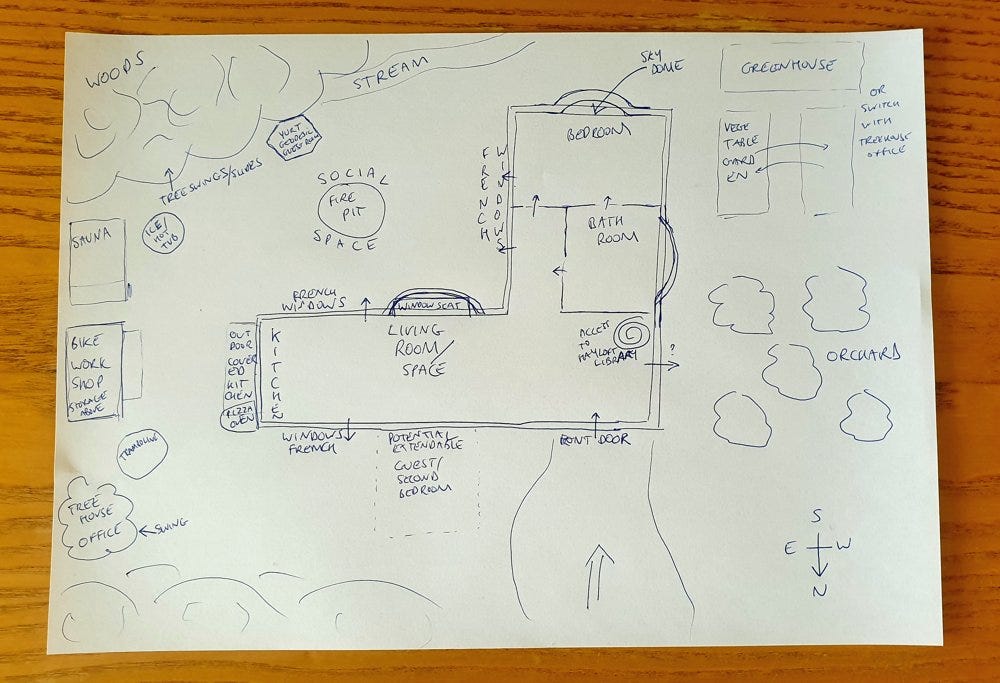Dream Architecture
When asked to imagine the future, we look around at what life we’re currently living, tweak it so it’s not raining quite so heavily, and that’s us.
Happy Friday!
And welcome to edition 322.
👋 My name is David and I’m a writer, outdoor instructor and cyclist-at-large with Thighs of Steel. I write stories that help you and me understand the world (and ourselves) a little better.
This week’s story is all about floor plans.
Specifically, the vital role they play in helping us first envision and then execute our most wondrous five and ten-year life-rocking ambitions.
Dream Architecture
Yesterday I finished reading The Men’s Group Manual by Clyde Henry. I’m not a member of a men’s group and I can’t really imagine joining, much less starting one right now, except perhaps in some kind of Temporary Autonomous Zone.
Nevertheless, I got a lot out of reading the book because it explains, as if to idiots, the principles of non-violent communication and gives clear instructions on how to build constructive conversations, designed to bond human beings as equals.
One of the suggested meeting topics in the book was for each man to draw the floor plan of a boyhood home. It’s a powerful exercise (for all genders, I’m sure) that can unearth long-buried memories.
I can get with that.
Sometimes, on the threshold of sleep, I imagine myself an invisible, weightless spirit-bird, flying over and around old homes, swooping between floors to explore each before rising starward again. Beats Netflix for me.
Anyway, at the end of the floor plan exercise instructions, Clyde Henry suggests a variation where everyone draws their ‘perfect dwelling’.
Henry doesn’t offer any interpretation of this idea, but it seems to me that, rather than throwing us back on our childhood, this variation could help us visualise, with pen and paper, a dreamy future.
As someone who dwells all too often in the abstract, the pen-and-paper practicality struck me as an important part of an important tool that might help me do something I’ve never done before…
Future Visualisation
How do you see your life in five years?
At first pass, this doesn’t seem like a tricky question. It’s the sort of question your careers advisor at school would ask and you’d roll your eyes and be like ‘Ugh, I’m gonna be dead by then. SO OLD.’
But when AW3T asked me this exact question a week ago, I realised that, aside from the increasingly teenagery ‘dead by then’ answer, I hadn’t a clue. Not a Scooby.
It turns out that, while some people can’t keep their mind’s eye off their Five/Ten/Fifty Year Plan, some people can scarcely imagine breakfast tomorrow, let alone the second middle name of their third grandchild-to-be.
(Side note: Is this a symptom of Man Sloth Mode? I suspect it may be.)
If you’ve got It All Planned Out, you can probably skip today’s story.
But if you’re stuck with me in the Breakfast Club — and, to be fair, that’s probably at least a quarter of you — then let’s crack on and find our futures.

(Crumpets are a good shout tomorrow, btw.)
In A Minute: Clyde Henry’s Floor Plan Task
But first, let’s be clear: humans are bad at imagining the future.
When we’re asked to imagine the future, we usually look around at what life we’re currently living, tweak it so it’s not raining quite so heavily, and that’s us.
And we’re particularly bad at imagining our own futures.
Jane McGonigal, lead author on the afore-pictured American Future Gap survey, explained it thusly in a 2017 article for Slate:
Typically, when you think about yourself, a region of the brain known as the medial prefrontal cortex, or MPFC, powers up. When you think about other people, it powers down. And if you feel like you don’t have anything in common with the people you’re thinking about? The MPFC activates even less.
The further out in time you try to imagine your own life, the less activation you show in the MPFC. In other words, your brain acts as if your future self is someone you don’t know very well and, frankly, someone you don’t care about.
Furthermore, and as if that wasn’t enough, as we imagine increasingly distant futures, our imaginings become commensurately vague.
(This is called Construal Theory. There’s no need for you to know that, but I spent ages reading about it for this story so now it’s your problem.)
This explains why, sure, I can plan complex things like cycling from Glasgow to Athens with 100 other humans, but my time horizon is six months tops.
So, while I have a very clear idea of what I’ll be doing between now and October, I couldn’t begin to describe what my life might look like in a year, much less five or ten years.
Imagining May 2023 is, for me, like trying to cloud-watch on a foggy day. Through steamed-up glasses.
Finally: Clyde Henry’s Floor Plan Task
And here is where we come back around to Clyde Henry’s floor plan task because marks made in ink on paper are both imaginative and practical.
That’s exactly why architects use both pen and paper to make detailed plans that bring into being actual houses with plumbing and cavity insulation. They don’t just vaguely tell builders to sort of, you know, build, like, a house with, er, walls and stuff, I guess?
And we in the Breakfast Club can use the same physical properties of pen and paper to force ourselves out of a purely hypothetical fantasy realm and into the realm of reality.
So I took half an hour and sketched.
Looking down at my floor plan sketch, I can see the light breaking over the woods and falling onto my lap as I lie drowsy in the bay window.
Standing up and pushing open the French windows, I can smell the resin of the wood and hear the far-off songs of swallow and stream.
I can feel the cool grass against my bare feet, and the heat of split logs, as I mooch over to the fire pit, just in time to take a s’more, flame grilled à point, from the outstretched hand of a friend.
There.
I have succeeded. I have visualised a future for myself that goes far beyond the here and now, beyond the six-month horizon. For this dream dwelling is surely situated, at bare minimum, five years from today.
But, dear Breakfast Clubbers, visualisation is only the start because now it’s time for the easy part…
Ice Cream Execution
Why do I call this the easy part? Because we’re Breakfast Clubbers.
We don’t have any problem with executing a plan in the here and now. We just never had a plan — until now.
Now we have our floor plan.
Okay, okay. There’s probably a bit more to it than that.
We might have to practise our floor planning over and over again before our futures take on the kind of single-minded clarity that we need to feel confidence in our vision.
But let’s give ourselves a pat on the back today. Until this morning, we’d never even had the confidence to picture our futures, let alone create them. Now at least we know how it’s done.
It takes courage to first imagine and then bring into being a life significantly different to the one you’re currently heavily invested in.
Courage, that is, or — favourite word claxon — audacity.
If audacity is a muscle you need to build, see also: The Best Things In Life Are Audacious and Audacity Is Our Only Option. I think I’m due a re-read as well.
More Ideas For Future Visualisation
Write down your task-by-task schedule from a dream day in 2027, complete with meal plans (don’t forget to brush your teeth).
Flip through a prospectus from a university, adult education college or anywhere else that sells future selves. Stop when something jumps out at you. Read the description carefully. What makes you connect to this future?
Make a scissors-and-glue collage of stuff that whispers big dreams to you. Whatever you do, don’t use a computer — print if you find something online.
Take a psychedelic and make notes.
Finally: use FutureMe to send your visualisations to yourself in a year’s time.
~
Thanks to A3WT for the gentle prod that resulted in the foregoing and, perhaps, the going forth.
100 Days of Adventure
🟢🟢🟢🟢🟢🟢🟢🟢🟢🟢🟢🟢🟢🟢🟢🟢🟢🟢🟢🟢
🟢🟢🟢🟢🟢🟢🟢🟢🟢🟢🟢🟢🟢🟢🟢🟢🟢🟢🟢🟢
🟢🟢🟢🟢🟢🟢⚪⚪⚪⚪⚪⚪⚪⚪⚪⚪⚪⚪⚪⚪
⚪⚪⚪⚪⚪⚪⚪⚪⚪⚪⚪⚪⚪⚪⚪⚪⚪⚪⚪⚪
⚪⚪⚪⚪⚪⚪⚪⚪⚪⚪⚪⚪⚪⚪⚪⚪⚪⚪⚪⚪
Gift Economy
These free weekly emails are supported by readers who scroll all the way to the bottom — readers like you 😁 Help unlock the commons for £30 per year—about 58p per newsletter.
Thank you.
Three Small Things At The End
MICRODOSING: Systematic review of research on low dose psychedelics finds ‘emerging evidence for possible improvements in mental health, substance use disorders, and psychological functioning’.
RUNNING: Run every street in your town with CityStrides. Apparently, I’ve got 49 ‘cities’ in progress, including Sciennes (a 17-street neighbourhood in Edinburgh, 17.65% complete), Bournemouth (a town of 1627 streets, 4.61% complete) and, er, Cornwall (7026 streets, 0.01% complete).
PLANT(AIN) MEDICINE: The common Greater plantain (broad leaves, bitter) and Ribwort plantain (narrow leaves, buds taste mushroomy) can both be used as ‘antihistamine, antifungal, antioxidant, analgesic and even a mild antibiotic’.
So, if you get stung by a nettle, use the juices from plantain leaves rather than dock, which apparently only works as a placebo.
If you’re by the sea, then, unfortunately, the salt-loving Stagshorn plantain (antler-like, toothed leaves) won’t do the same job — but their leaves are delicious in a salad.
Big love,
dc:


